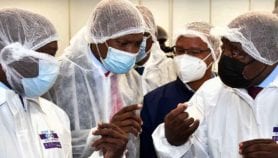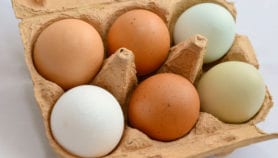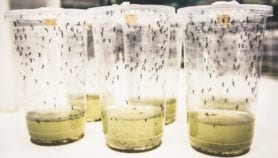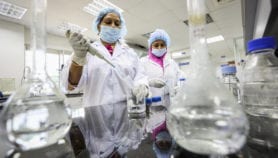By: Carol Campbell
Send to a friend
The details you provide on this page will not be used to send unsolicited email, and will not be sold to a 3rd party. See privacy policy.
GM crops were supposed to rescue the world’s one billion undernourished people. Carol Campbell discusses whether they will ever curb hunger.
[OUDTSHOORN] Golden Rice burst into the public imagination a decade ago, in the form of a cover article in Time magazine that claimed the genetically modified (GM) rice could "save a million kids a year".
The rice gets its golden hue from an excess of beta carotene, a precursor to vitamin A that could help half a million children who go blind each year from an often-fatal vitamin A deficiency.
The public versus GM
Co-inventor Ingo Potrykus points to resistance to GM technology from pressure groups such as Greenpeace that has resulted in public and governmental resistance — including fears that rogue GM genes may contaminate wild varieties or that GM technology services corporate greed and will never help the poor.
This has led to "excessive" regulations that have choked efforts to roll out GM crops that might feed the poor, he says.
And there are other concerns — the cost; the slowness of the research; even the idea that a "magic bullet" approach to nutrition can provide the answer to what is, some argue, a social, cultural and economic problem.
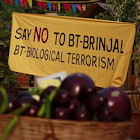
Developing countries have generally been cautious about GM crops
Flickr/Joe Athialy
Does this mean that all GM foods are fated never to solve the undernutrition of the poor? If public resistance dwindles, will the crops live up to their promise to help feed the world’s undernourished (estimated by the UN Food and Agriculture Organization (FAO) to number one billion in 2009)?
Rowan Sage, one of the scientists working on the creation of ‘C4 rice’ — another engineered rice that could one day produce a radically improved yield — says it is crucial to get public approval if GM is to tackle malnutrition. The social obstacles are huge, he says, and acceptance is "critical" for C4 rice’s success.
"We have got to get buy-in because they [the hungry poor] could easily just say they don’t want it," says Sage, an ecological and evolutionary biologist at the University of Toronto, Canada, working with the Philippines-based International Rice Research Institute (IRRI) on the project.
Guillaume Gruere, a research fellow at the International Food Policy Research Institute (IFPRI) believes that most of the reasons behind the fact that there are no publicly-developed GM food crops available for the poor can be traced back to resistance.
Many of the obstacles in developing countries have "in large part resulted from influences from countries and organisations opposed to the use of GM food", Gruere says.
Some GM proponents are pessimistic that these issues will be resolved anytime soon. For example, HarvestPlus, a global programme aimed at creating more nutritious staple crops, is avoiding GM technology almost entirely and using conventional breeding instead.
But many people believe resistance will eventually wane.
Robert Ziegler, director-general of IRRI, says it’s unlikely that those opposing GM will be able to hold back the technology forever.
"In general the issue in many developing countries is that they don’t have a regulatory framework to handle them [GM crops]," Ziegler told a meeting of the American Association for the Advancement of Science (AAAS) in Chicago last year (2009).
"There are pretty strong, mostly Europe-based, lobbies who oppose their use in Sub-Saharan Africa. I think that as crops that have direct benefit to consumers come on board they will eventually be accepted."
Even Golden Rice is making some progress, he said. It is being field tested in the Philippines and the first batches may be commercially available by 2011–12.
A balanced diet
But even if opposition evaporates, there are other reasons why GM crops may fail to solve the problem of malnutrition — will tackling one particular nutritional deficiency ever bring broad success in a war that concerns so many nutrients?
For Doug Gurian-Sherman, a senior scientist in the Food & Environment Program at the US-based Union of Concerned Scientists, introducing genetically-engineered crops into a developing world environment is a piecemeal approach.
"Nutritional deficiency in an impoverished community would be better addressed by encouraging and helping people eat a balanced diet that includes green leafy vegetables and protein rather than trying to pack everything into cassava or rice," he says.
People with one deficiency often also have other nutrient deficiencies that will not be addressed by this kind of single-nutrient approach, he argues.
"I am not opposed to Golden Rice, if it works and is shown to be safe. But is it really a good use of development resources?"
Using GM to tackling a range of deficiencies in one go is the goal of the BioCassava Plus project, which aims to pack almost a full meal into cassava, a staple for 250 million people in Sub-Saharan Africa.
Turning cassava into a square meal



Cassava is a staple for 250 million people in sub-Saharan Africa but it has a short shelf life, is plagued by disease and is not nutritious
Flickr/shanidov
The GM cassava is engineered to be more nutritious on several counts and to have a longer shelf life, disease resistance and lower cyanide levels. Early versions of the plant, with one or two characteristics introduced, are undergoing field trials in Nigeria and Puerto Rico, and is set to be tested in Kenya.
The initiative is under the supervision of Richard Sayre from the Donald Danforth Plant Science Center in the United States.
Sayre rejects Gurian-Sherman’s argument: "We know our cassava can help people," he says. "Initial estimates are that, in the first round of production, 35,000 lives will be saved in Nigeria. The long term impact is millions of lives saved."
Such claims are beguiling, but what about the cost when there’s a limited international pot from which to fund nutrition?
Gurian-Sherman argues that the costs are so high that efforts should go elsewhere. A new biotechnology crop, he says, could cost up to US$100 million to produce (excluding regulatory costs) while the same crop improved through traditional methods would cost US$1 million.
In the case of C4 rice, the development costs are vast, says Sage.
"It is extremely expensive work," he told the AAAS meeting. "In order to create a sustained programme it needs US$10 million a year."
But, he argued, "it’s cheap compared with the benefits". C4 rice could, he says, increase yield by 50 per cent — and the benefits of that are in the trillions of dollars.
The C4 project must therefore be viewed in the long term to understand its benefits. It will take two to three decades to come to fruition but could help solve the food challenges of 2050, he said.
So perhaps by 2050, with biosafety frameworks in place, resistance to GM subdued by the growing trouble of world hunger, and comprehensive GM solutions that solve a host of deficiencies in a single plant, GM might solve the problem of malnutrition?
Is GM a crude solution?
But there is still one major objection — that the problem of poor nutrition is so complex that it is crude to think it can be solved by GM.
The poor don’t get enough food for a number of reasons: infrastructure, such as poor roads along which to take their goods to market; lack of fertiliser; lack of training in farming methods.
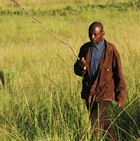


Developing country farmers face many agricultural production pressures
Flickr/JP-Flanigan
The rise of monocultures has reduced the variety of their diets. Land is distributed inefficiently or unfairly with the poor pushed onto unproductive land — and this requires legal reform followed by implementation. Popping a gene into a tomato is not going to solve these problems, it is argued.
Andrea Roberto Sonnino, a senior agricultural research officer at the Research and Extension Unit of the FAO in Italy, says: "GM can contribute to improved nutrition but we have to consider that nutrition is a result of many social, cultural, economic and political factors".
To improve the nutrition of the poor, action cannot be limited to the improvement of the nutritional quality of a particular crop, he says.
Bonnie McClafferty, head of development and communications at HarvestPlus agrees.
"The enormity and complexity of the problem means we need [many] solutions to be made available, including diversifying diets, commercially fortifying foods, administering nutrition supplements, and breeding crops to be rich in vitamins and minerals," she says.
"While the amounts of desired nutrient in food crops can be enhanced through conventional breeding, where these nutrients are not found in parent breeding lines, or cannot be increased in the amount needed to improve nutrition, GM foods can be seen as part of the solution."
"GM technology may well be able to go beyond where conventional plant breeding can take us."
Perhaps, as with the approach to climate change, the solution lies in a web of interventions of which GM may be one.
And, like climate change, it may be foolhardy to ignore any of them.
Carol Campbell is a freelance science journalist based in Oudtshoorn, South Africa
See Letter to the editor.





